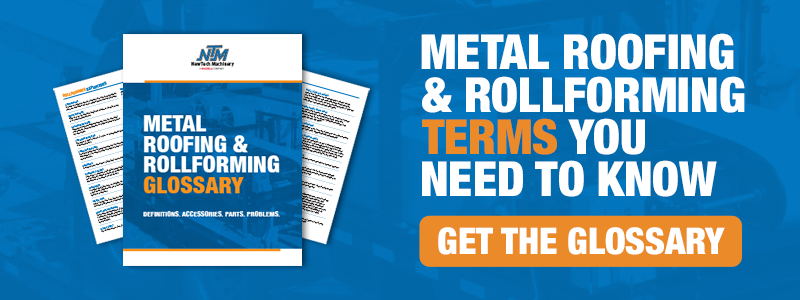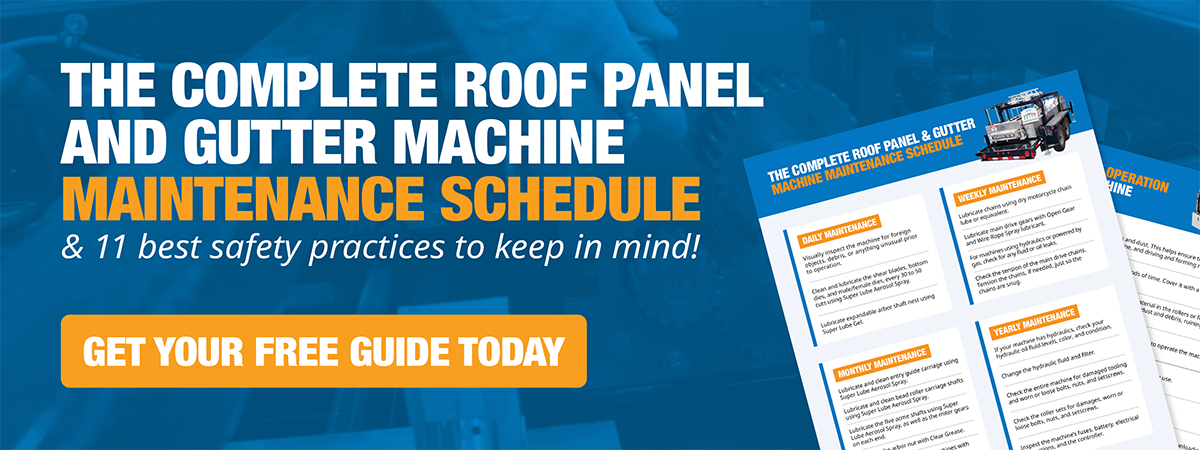When looking at portable rollforming machine design, forming rollers and drive rollers vary from manufacturer to manufacturer. Some machine manufacturers separate these two rollforming machine parts, and some may utilize the driven rollers as the forming rollers.
If you’re unsure what to consider when choosing the best portable rollforming machine for your business, understanding what these components do and how having them as separate parts can be beneficial to the machine’s overall functionality and creation of a quality metal roof panel or gutter, can help you with your decision on machine manufacturers, brands, and machine types.
At New Tech Machinery (NTM), we understand the importance of knowing the workings and functionality of the equipment you’re going to purchase to be a completely educated consumer. That’s why we explore what you need to know about forming rollers, drive rollers, and why understanding their design inside a portable rollformer is important to know before purchasing one.
In this article, we’ll explain:
- What are forming rollers and the types of forming rollers used in rollforming machinery
- What drive rollers are and what they are made of
- How separating these components can help in the metal forming process
- How to take care of the drive and forming rollers inside a portable rollformer
Parts of a Portable Rollforming Machine: What Are Forming Rollers?

Forming rollers are individual parts inside a portable rollforming machine that material passes through and is bent to be formed into a specific profile or shape. Typically, the forming rollers are made of stainless or hard-chromed steel and are put together in a particular progression inside the machine. As the material passes along each roller set, the bends become more complex.
Types of Forming Rollers: Free-Floating vs. Driven
Forming rollers used in metal forming equipment are typically either free-floating or driven. What’s the difference?
Free-floating forming rollers only operate as material passes through them and gradually use that friction to form the material to the desired profile. They don’t utilize any power to make them spin on their own, unlike powered or driven forming rollers. The material passes through factory-set gaps in the forming rollers sets, allowing various types and gauges of material to run through the machine without needing to readjust the gaps.
Driven forming rollers or powered forming rollers are more complex as they pull the material through the machine and form it to a specific roof or gutter profile. Typically made of stainless steel or hard-chromed steel, these smooth rollers have to be adjusted every time you change material type or gauge, which can be a time-consuming process.

Parts of a Portable Rollforming Machine: What Are Drive Rollers?

Drive rollers, usually made of polyurethane or steel, are the systems inside a metal forming machine that pull and guide the material through the machine. Typically they’re on a chain drive system so they can operate at the same speed throughout the machine.
On a New Tech Machinery roof panel machine or seamless gutter machine, the drive rollers are made of a proprietary polyurethane blend exclusive to NTM products. It can be hydraulically or electrically powered, depending on the machine. Polyurethane rollers must be kept clean and well-maintained. Otherwise, they can leave marks or debris on the material as it passes through the machine.
Steel Drive Rollers vs. Polyurethane Drive Rollers
As stated before, drive rollers can be polyurethane, stainless steel, or hard-chromed steel, but how does that impact the rollforming process?
Portable rollforming machines with steel rollers that both form and drive the material require that the material remains loaded into the machine during transport and storage. The reasoning behind this is to maintain the specific gaps between the rollers and prevent the top and bottom rollers from hitting against each other while traveling to job sites or when in storage.
This material can also serve as a conveyer for anything that falls into the machine during transport (like a screw, nail, etc.) Any items that fall into the machine will eventually pass through the machine when turned on and cause damage to the drive / forming rollers. This material has to be run out of the machine and discarded at the job site, wasting a lot of costly material and time.
With polyurethane drive rollers, you only need to make minor or no adjustments at all when switching from one material type or gauge to another. Urethane is also a softer material and more forgiving than its steel counterpart. Keeping material loaded in the machine during transport is not required or recommended on drive systems that use polyurethane. Settings and adjustments are also better maintained in these machines than those that use the same components to drive and form material.
How Forming Rollers and Drive Rollers Are Designed in Portable Rollforming Machines

How forming and drive rollers work inside different manufacturers’ portable rollforming machines may vary. The forming and drive rollers can be the same component, powered to pull the material through the machine and form them into specific profiles. However, this is not the case with all portable rollforming machines. Some manufacturers, like NTM, may separate the functions and parts of the forming and drive rollers. There are some advantages to having the drive and forming rollers separated in a metal forming machine.
Metal forming or rollforming is a gradual process that involves metal taking on a form that’s different from the way it started (usually a flat sheet). Any manipulation in this material will cause it to react. Metal, in its nature, wants to bend back to a flat shape. The more gradual and slight the bends you create at each forming station, the better the end product will be and will mean less stress on the material as it goes through the machine.
On rollforming machines that utilize stainless or hard-chromed steel, drive rollers also act as the forming rollers. These driven pieces have a mirror finish and are very slick. Because of this design, there have to be gaps between the top and bottom drive / forming rollers less than the thickness of the material so they can adequately grip and pull the material through the machine and form it simultaneously. This compresses and stretches the material, so you have to make adjustments every time you switch material thickness or type to counteract this compression.
These forming rollers must all operate simultaneously to ensure one station isn’t creating more pull on the material than another, which can create distortion or oil canning of the material.
This compression is nearly eliminated by using polyurethane and having separated drive and forming rollers. The drive rollers only drive the material and can be set to a certain factory specification that will drive most materials through the machine without compressing them and without needing to readjust them when changing from various materials and thicknesses. The separate free-spinning forming rollers only form the material, and the material goes through the machine with the powered polyurethane drive rollers.
Maintenance of Roller Systems in a Portable Rollforming Machine

The forming rollers and drive rollers on your metal roof panel machine or seamless gutter machine work only as well as they are taken care of. Regular maintenance of these components on your machine helps ensure that they last longer and don’t potentially damage the material during the rollforming process.
When doing any maintenance on your portable rollforming machine, here are some procedures to keep in mind to clean your forming and drive rollers and keep them in top condition:
- Clean your stainless steel forming rollers as needed with mild solvents and a Scotch-Brite™pad.
- Never use solvents to clean polyurethane drive rollers. Use a mild general-purpose cleaning product like Simple Green®, clean cloth rags, and possibly a green Scotch-Brite pad to remove dirt and grime on your roller sets. Download this free set of drive roller cleaning instructions for the proper and safe way to maintain and clean your drive rollers.
- It’s not recommended to transport a polyurethane drive machine with any material left inside. The material acts as a conveyor and can collect dust, debris, and other foreign objects, potentially damaging the rollers or leaving flat spots in the polyurethane drive rollers (that will usually work themselves out but may take time depending on the outside temperature).
- Lubricate the Shear Blade every 30 to 40 cuts using a dry silicone or similar lubricant.
- Lubricate the chains on the drive system at least every 40 hours of machine operation with dry motorcycle lubricant and keep the chains properly tensioned. They should be just snug.
For more instructions on maintenance, troubleshooting, or general operation of your portable rollforming machine, download your machine manual here.
Any machine should never be operated without the covers and guards in place. Otherwise, severe injury can occur. The machine must be operated by a competent trained individual and never be operated by a person who has not had proper training, studied the video and the latest operating manual found here. Failure to operate correctly or without guards can result in severe injury.
Final Thoughts
The forming rollers and drive rollers are essential components of any portable rollforming machine. Still, the materials they’re made of and their design can vary in each manufacturer’s machine. That’s why it’s important to know what they do, how to maintain them, and how they’re designed in different machinery, so you can choose the best machine and manufacturer for your operations.
For many years, New Tech Machinery has used polyurethane drive rollers and kept both forming and drive rollers as separate components inside portable rollforming equipment. It has proven to be the best material and method available for getting the highest quality end product, the longevity of your portable rollforming machine, and for easy maintenance. If you have any questions about our products or need service assistance, reach out to any of our rollforming specialists.

